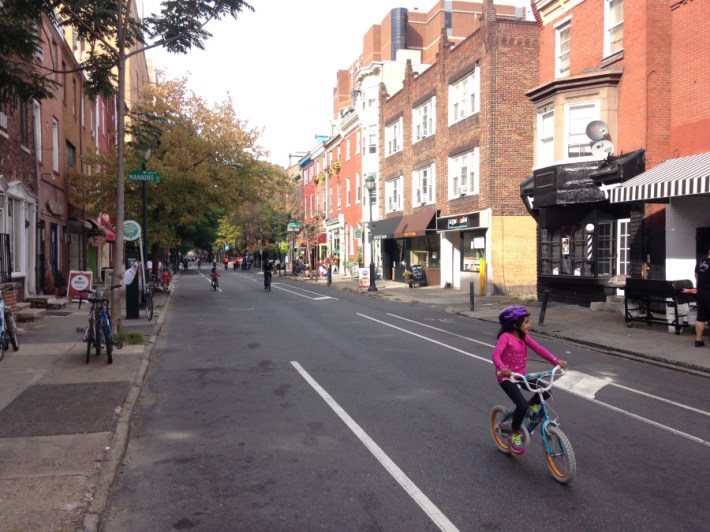Father-son soccer in the street on 16th near Spruce pic.twitter.com/Mt47dbiHJo — Will Bunch (@Will_Bunch) September 27, 2015
The official name for it was the "traffic box" -- the 4.7-square-mile chunk of center city Philadelphia where incoming motor vehicles weren't allowed when Pope Francis was in town this weekend. But rather than the traffic nightmare some anticipated, something wonderful happened: #popenstreets.
Suddenly the streets felt public. Neighbors were hanging out together. Kids played. Holly Otterbein at Philadelphia Magazine called it "an urbanist utopia":
Blissed-out pedestrians are walking down the middle of roads as big as Broad and Market, and hordes of people are crossing the Benjamin Franklin Bridge. Cyclists are giddy by the extra room. Some residents are even turning the streets into impromptu picnic spots and playgrounds.
The local media, and a lot of residents, were generally euphoric about the situation. In another article, Philly Mag listed "10 Reasons Why Philadelphia Is a Better Version of Itself Right Now." One reason being: "There's none of the undercurrent of anger and tension that you see when bikes and cars are on the road at the same time."
This whole #PopenStreets thing is phenomenal. @JimFKenney seriously this plus @septa let's ban cars all the time pic.twitter.com/ko1D0CxRfZ — Victoria (@108_Victoria_St) September 26, 2015
"It's like a block party," one reveler told the City Paper, which was a common sentiment. The Inquirer wrote that the closed Ben Franklin Bridge was "one big block party."
Biggest crowd of the day so far...Priests playing frisbee on 2nd. @CBSPhilly #CBSPhillyPope pic.twitter.com/5t08Ylb8qE — Michael Cerio (@TheMichaelCerio) September 26, 2015
Large group of pilgrims from Newark makes its way crossing BFB to attend #PopeInPhilly (photo for @NewsWorksWHYY ) pic.twitter.com/soA49bSFgM
— Bastiaan Slabbers (@BasSlabbers) September 26, 2015
Rebuilding the Rust Belt said the car-free days enabled "people to experience human-oriented streets, the sudden and widespread freedom from cars had an effect no amount of logic, graphics, advocacy, or public meetings could achieve."

There was even a Pope Ride, where swarms of people on bikes took advantage of the absence of cars to take part in a 10-mile group ride.
At the starting line for the #poperide. [ Be sure to follow us on Twitter @ RideIndego for weekend updates, puns and more ] #rideindego #popeinphilly A photo posted by Indego (@rideindego) on
Following the PopeRide, the city's likely next mayor, Jim Kenney, said Philly should open its streets "even when the pope's not here." Inquirer architecture critic Inga Saffron agreed.
Hat tip: Plan Philly





